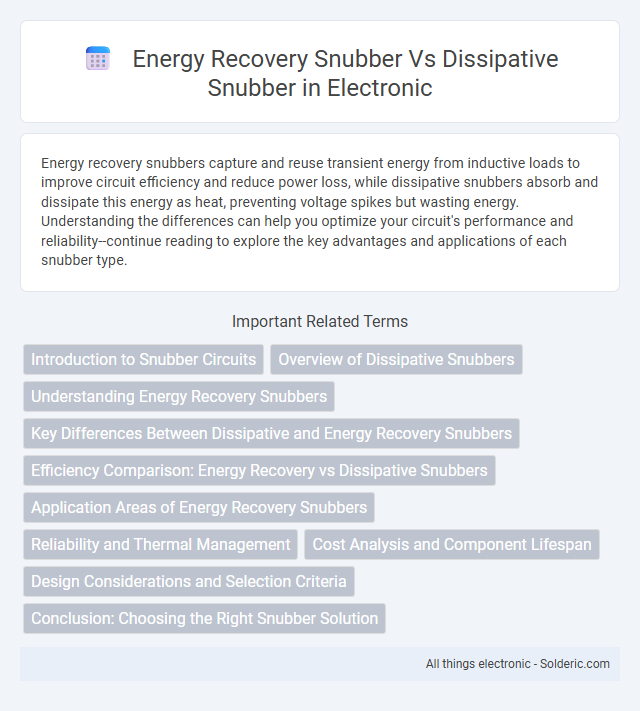Energy recovery snubbers capture and reuse transient energy from inductive loads to improve circuit efficiency and reduce power loss, while dissipative snubbers absorb and dissipate this energy as heat, preventing voltage spikes but wasting energy. Understanding the differences can help you optimize your circuit's performance and reliability--continue reading to explore the key advantages and applications of each snubber type.
Comparison Table
| Feature | Energy Recovery Snubber | Dissipative Snubber |
|---|---|---|
| Function | Recovers and reuses energy from voltage spikes | Dissipates energy as heat to protect components |
| Energy Efficiency | High - reduces power loss | Low - wastes energy as heat |
| Component Complexity | More complex - includes inductors, capacitors, and switches | Simple - typically resistors and capacitors |
| Cost | Higher due to additional components | Lower, uncomplicated design |
| Thermal Management | Reduced heat generation | Requires heat sinks or cooling |
| Application Suitability | High-power circuits needing efficiency | Low to medium power circuits focused on simplicity |
| Switching Losses | Minimized due to energy recovery | Higher because energy is dissipated |
Introduction to Snubber Circuits
Snubber circuits protect power electronic devices from voltage spikes and improve system reliability by controlling transient voltage and current. Energy recovery snubbers store and reuse the energy from these transients, enhancing efficiency and reducing power loss. Dissipative snubbers absorb the excess energy as heat, providing simpler design but with lower energy efficiency compared to energy recovery types.
Overview of Dissipative Snubbers
Dissipative snubbers absorb excess energy in electrical circuits by converting it into heat through resistive elements, effectively protecting components from voltage spikes. These snubbers are simpler and less expensive compared to energy recovery snubbers, but they lack energy recycling capability. Commonly used in power electronics, dissipative snubbers reduce stress on switches and improve system reliability by dissipating transient energy safely.
Understanding Energy Recovery Snubbers
Energy recovery snubbers store and reuse the energy generated during switching, improving overall circuit efficiency and reducing power loss compared to dissipative snubbers that convert excess energy into heat. Your system benefits from enhanced energy efficiency and reduced thermal stress when using energy recovery snubbers. These snubbers are ideal for applications requiring high-frequency switching and energy conservation.
Key Differences Between Dissipative and Energy Recovery Snubbers
Energy recovery snubbers store and reuse the energy generated during circuit switching, improving efficiency and reducing power loss, while dissipative snubbers convert this energy into heat, leading to higher energy dissipation but simpler design. Energy recovery snubbers typically incorporate inductors or capacitors to recycle energy, making them ideal for applications requiring energy efficiency and minimal thermal stress. Your choice between these snubber types should consider factors such as power loss, thermal management, and circuit complexity to optimize performance.
Efficiency Comparison: Energy Recovery vs Dissipative Snubbers
Energy recovery snubbers significantly improve circuit efficiency by capturing and reusing energy that would otherwise be lost, whereas dissipative snubbers convert this energy into heat, resulting in lower overall efficiency. Your system benefits from reduced power loss and enhanced performance when utilizing energy recovery snubbers, especially in high-frequency switching applications. Choosing the right snubber type impacts thermal management and energy savings in power electronics design.
Application Areas of Energy Recovery Snubbers
Energy recovery snubbers are primarily used in renewable energy systems, such as solar inverters and wind turbine converters, to enhance energy efficiency by recycling excess energy. They find application in motor drives and power electronics where reducing energy loss and improving thermal management are critical. These snubbers are also favored in electric vehicle powertrains for their ability to recover and reuse energy during switching operations.
Reliability and Thermal Management
Energy recovery snubbers enhance reliability by recycling energy back into the system, reducing thermal stress on components and extending their lifespan. In contrast, dissipative snubbers convert excess energy into heat, requiring robust thermal management solutions to prevent overheating and component failure. Your choice impacts system durability and cooling requirements, with energy recovery snubbers offering improved thermal efficiency and longevity.
Cost Analysis and Component Lifespan
Energy recovery snubbers typically offer lower operating costs due to their efficient energy recycling, reducing overall power losses and extending component lifespan by minimizing stress on switches and passive elements. In contrast, dissipative snubbers incur higher energy dissipation as heat, leading to increased cooling requirements and more frequent component replacements, which elevate maintenance expenses. Choosing the right snubber can optimize Your system's long-term cost-effectiveness and enhance reliability through extended component durability.
Design Considerations and Selection Criteria
Energy recovery snubbers improve efficiency by recycling stored energy back into the system, reducing power loss and thermal stress, making them ideal for applications requiring high efficiency and thermal management. Dissipative snubbers convert excess energy into heat through resistors, providing simple design and reliable protection but with lower energy efficiency and increased thermal dissipation requirements. Your selection should consider factors such as switching frequency, power rating, thermal management capabilities, and overall system efficiency goals.
Conclusion: Choosing the Right Snubber Solution
Energy recovery snubbers efficiently recycle energy back into the circuit, enhancing overall system efficiency and reducing power loss, making them ideal for high-frequency applications and energy-sensitive designs. Dissipative snubbers absorb and dissipate excess energy as heat, offering simpler implementation and better protection in circuits where energy recovery is not critical. Selecting the right snubber depends on balancing efficiency, complexity, and thermal management requirements specific to the application.
energy recovery snubber vs dissipative snubber Infographic

 solderic.com
solderic.com